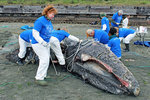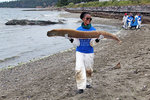The body of a gray whale found dead in the Puget Sound earlier this month is now destined for a new life in education thanks to the Port Townsend Marine Science Center (PTMSC).
“The educational …
This item is available in full to subscribers.
We have recently launched a new and improved website. To continue reading, you will need to either log into your subscriber account, or purchase a new subscription.
If you had an active account on our previous website, then you have an account here. Simply reset your password to regain access to your account.
If you did not have an account on our previous website, but are a current print subscriber, click here to set up your website account.
Otherwise, click here to view your options for subscribing.
* Having trouble? Call our circulation department at 360-385-2900, or email our support.
Please log in to continue |
|


The body of a gray whale found dead in the Puget Sound earlier this month is now destined for a new life in education thanks to the Port Townsend Marine Science Center (PTMSC).
“The educational opportunities this presents for our students and volunteers are powerful and unique,” Janine Boire, PTMSC executive director, said in a press release.
In cooperation with students and community volunteers, the science center on the waterfront at Fort Worden plans to eventually articulate, or reconstruct, the whale's skeleton for educational use in classes and exhibits.
DEATH
The whale, a female likely between ages 2 and 4, was first sighted alive in late April in central Puget Sound near Kingston struggling to swim and dive as a result of an injury or illness that trapped gases in the upper part of its body.
On May 8, the whale, identified as CRC-1524, was found dead in Elliott Bay near downtown Seattle. Cascadia Research Collective and the Washington Department of Natural Resources towed the whale’s carcass May 11 to a Port Townsend Bay beach at Naval Magazine Indian Island made available by the U.S. Navy for necropsy.
PTMSC staff and AmeriCorps members assisted in the necropsy May 12, the results of which help NOAA Fisheries understand the whale’s injuries and the cause of death, which could provide insight into health risks affecting gray whales.
Biologists and veterinarians suspect the whale may have been suffering from an infection that produced gas inside its body or a pneumothorax – a collapsed lung – that had filled its chest cavity with air. Either condition could have made the animal too buoyant to dive. Gray whales feed by diving to the sea floor and sifting sediment for small marine organisms, such as tiny crustaceans.
COLLECTION
A team of 20 volunteers and PTMSC staff, with oversight from veterinarian Dr. Pete Schroeder of the National Marine Mammal Foundation, collected the carcass May 18 from the Crane Point beach across the bay from Port Hadlock.
After removing its entrails, pectoral fins and baleen, the team wrapped the 30-foot, 30,000-pound whale in Spectra netting provided by fisherman Kwin Bailey and sunk it offshore, allowing it to decompose naturally for one-to-two years. Once decomposed, its skeletal remains are to be retrieved, cleaned and prepped for reconstruction, also known as articulation.
Boire said the whale's body, even while decomposing, offers many educational opportunities, “from using submersible ROV technology for monitoring the whale's decomposition, to working with community volunteers in articulating the skeleton, all the way through to providing the legacy of the whale's bones on permanent exhibit.”
HOPE
In 2008, a team of 25 volunteers and PTMSC staff members began the process of exhuming, cleaning and fully articulating the skeleton of CA189, a female orca found stranded near Dungeness Spit in 2002. This process, led by articulation specialist Lee Post, of Homer, Alaska, was highly unusual in how much of the work was carried out not by scientists, but by community members, who lent their time and many diverse skills to the project.
The female orca’s body carried one of the highest loads of toxic chemicals ever recorded in a marine mammal. Local children who learned about her story through PTMSC’s education programs gave her the name “Hope.”
Hope’s articulated skeleton became the focus of the orca exhibit at PTMSC to raise awareness of orcas, the threats they face and things we can do to help them survive.
THANKS
The Port Townsend Marine Science Center thanks NOAA Fisheries for offering use of the whale skeleton for educational purposes, the U.S. Navy for their efficient assistance on site, Dr. Pete Schroeder for his expertise and guidance in preparing the whale, and the countless individuals, groups and agencies that assisted in monitoring and towing the whale or supporting the effort, including Cascadia Research Collective, Washington Department of Fish and Wildlife’s Marine Mammal Investigations, Washington Department of Fish and Wildlife’s Enforcement, Washington State Parks, Washington Department of Natural Resources, U.S. Coast Guard, Seal Sitters, Orca Network, Seattle Aquarium and the SeaDoc Society.